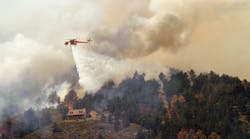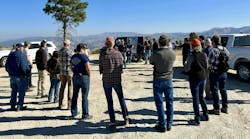When a disaster strikes, most people think of firefighters, the Red Cross, search-and-rescue teams and others as first responders to the scene, but many forget a crew that is just as critical — the crew made up of linemen.
Poudre Valley Rural Electric Association linemen were first on the scene right alongside firefighters and other first responders when the High Park fire ignited west of Fort Collins, Colorado, U.S., in 2012. In the fall of 2013, when floodwaters gushed through the foothills and plains of northern Colorado, most of those same linemen were actually some of the first to gain access to the flood-affected areas, providing necessary assistance in responding to the disaster.
Above and Beyond
A lineman’s job is truly a professional trade. Our linemen are well educated, experienced and know the trade like the backs of their hands. The job is already dangerous, considering linemen are working on distribution lines every day, but add in the component of a natural disaster, and the job becomes much more difficult.
When dealing with fallen power lines from the floodwaters and forest fires, PVREA crews worked hard and fast to restore power quickly, but they also kept safety a priority. It’s one thing to do routine maintenance on a normal workday; it’s a completely different situation when a natural disaster hits and work has to be done in emergency mode, and lives are on the line. While job safety is important to everyone — no matter the occupation — for linemen, there can be no slip ups, because mistakes can cost a limb or, even worse, a life. That’s one of the reasons linemen form lifelong bonds that last long after they are done working as linemen.
Dual Disasters
When snow is falling hard, ice is accumulating on a wood pole and the weather is so cold your fingers are freezing inside your gloves, climbing a pole is, at the very least, a difficult task. When the winds are taking down lines, and members are staying inside to keep out of the rain and windy conditions, linemen are out in the elements, heading up in a bucket truck 40 ft off the ground.
When the High Park fire started on June 9, 2012, it was a Saturday, and crews were spending time with their families, enjoying their day off. However, when notified about the disaster, PVREA linemen quickly reported to duty and headed into the foothills. The fire blazed across our service territory and affected 1,700 members, eventually destroying more than 250 homes, 10 miles of line and 400 poles.
The fire burned for four weeks, and at one time, it came within 50 ft of one substation. Crews worked in emergency mode for three weeks, and by June 24, two weeks after the fire started, all but 30 services were restored. The fire was not even declared 100% contained until July 1.
Even as the experiences of the High Park fire still burned in our memories and our members were struggling to rebuild, a year later, another natural disaster inundated northern Colorado, affecting many families in our service territory. In September 2013, a flood hit the region and washed away 485 miles of roads, creating a literal roadblock for first responders to get into some areas. In the hours after water began to rise, PVREA crews were among the first to gain access and respond to the disaster. Because our trucks have a high clearance, they were able to withstand rugged conditions that allowed crews access to remote areas.
In areas where there were no official travel restrictions, crews worked into the night. They rotated shifts over weekends and evening hours, bringing electricity to those most in need. A PVREA management team traveled out to the flooded areas every day to work with local and federal officials to gain access to areas without power as soon as they were opened. In many cases, trucks followed rights-of-way and forest service easements to repair lines.
During this second emergency, more than 2,600 of our members were affected. Our crews worked nonstop, but safety remained our top priority. The floodwaters took down 150 poles and 160 spans of line. However, with the hard work of our crews, we were able to restore service to all but 300 members within one month.
Critical Coordination
In both natural disaster situations, coordinating crews and material, and planning restoration took a well-organized effort among emergency agencies and internally at the cooperative headquarters. It was critical to ensure the safety of our crews while restoring power to those who were without it as quickly as possible. This significant coordination and planning was crucial in allowing crews access to where they needed to be and to have the materials they needed to get the job done.
Of course, we hope never to see natural disasters like these again, but we know we are ready to deploy if and when a natural disaster strikes.


